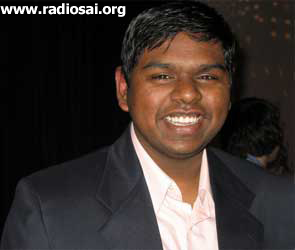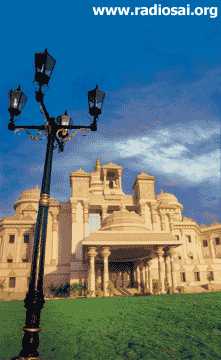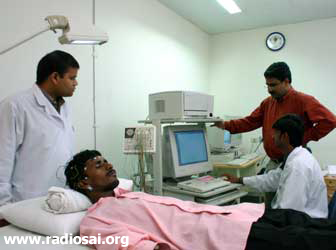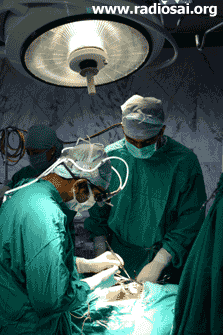 |
 |
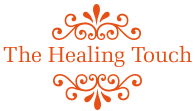 |
 |
| Volume 4 - Issue 10 OCTOBER 2006 |
|
A RARE EXPERIENCE OF LEARNING AT THE TEMPLE OF HEALING The firsthand experience of a premed student undergoing “Many are called but few are chosen,” is an aphorism with biblical references. The opportunity of learning from an existing institution that free medical care is both possible and sustainable is open to all. The choice to come and learn is left to the interest and commitment of the individual. People from many walks of life have visited the SSSIHMS both at Prasanthigram and Whitefield and the outcome of consequent interactions has definitely been synergistic. The requirement for admission into medical schools is changing, especially in the West. Students are asked to get exposed to practical aspects in hospitals before embarking on a medical career. The making of a doctor requires unique skills and psychological makeup apart from sheer scholastic excellence. One student from the USA, Suraj Yalamuri, visited SSSIHMS Whitefield on that mission. He observed clinical work and participated in research. He also helped in preparing a presentation and participated in the symposium “Spirituality and Sai Health Mission.” This is his story in his own words. Suraj Yalamuri Narrates His Story - The Preparation
The question becomes, “Why do you want to help people medically?” and “What experience have you had that makes you think so?” So how does one gain clinical experience even before entering medical school? These questions racked my brain during the summer of 2005. My interest in medicine and my desire to help people began quite early. Coming from a devout Hindu family, we went to temple every Saturday. Outside the temple, there sat a group of disabled beggars and I always borrowed money from my dad and gave it to them. There was one man who sat at the very end. His legs looked normal but he could not walk. I asked my mom why and she simply said, “I don’t know. But I bet a doctor might.” Later, as I was putting on my shoes, she said, “You know a doctor is the only person who can directly make a difference in someone’s life.” This incident inspired my interest in medicine. I remember at my first visit to the optometrist I was fascinated by the model of the eye resting on the reception counter. After coming home, I questioned my dad on how the eye worked. Being an engineer he drew an analogy between the parts of the video camera and those of the eye. I remember staying up past my bedtime learning about the differences and similarities between cameras and eyes. As I went to my room, my dad jokingly mentioned that if he were to replace my eyes with a camera I might not trip over myself and walk properly. Little did I know at the time that in the near future this would become a potential alternative for providing vision to blind people and I would be spending vast amounts of my free time researching the topic. This initial kernel of interest in medicine developed into a passion. In high school, I took rigorous and Advanced Placement courses to learn the basics of physical and biological sciences to better prepare myself for college. Outside of school, I attended seminars and talks given by visiting scientists and medical doctors to the Portland Metropolitan area. One of my favorite and inspiring lectures was on medical engineering marvels. The topics covered included the artificial heart, artificial blood, and electronic glasses providing vision to blind people. These embodied the application of knowledge and drove my interest into research. Throughout my junior and senior years in high school, I worked on a research project which resulted in a computer model of the environmental impact of greenhouse gases. The resulting project was awarded second place in the Intel Northwest Science Expo in the field of Chemistry and Environmental Sciences. Even though the project was not directly related to the field of medicine, it provided me with the basics of scientific inquiry and methods I now use regularly in the research lab at the Institute of Neuroscience at the University of Oregon. My research focuses on the synaptic cell adhesion molecule SynCAM and I am characterizing the six different isoforms of this molecule found in the brains of mice. Having been involved in the technical and research area of biosciences, I was eager to gain clinical experience and have direct interaction with patients. The problem was I did not know what to look for in the profiles of the internships being offered. I made independent research and found programs designed for premedical students at Harvard, Duke, and the Oregon Health and Science University (OHSU).
At the beginning of my internship, I spent several days in the Neurology Department with Dr. Suresh. I observed clinical diagnosis of patients and consultations with the doctor. It was enlightening to see how a physician is able to get across the diagnosis to patients who are not well educated and from very poor backgrounds. Dr. Suresh took the time to help the patients understand. I was surprised he was able to speak many Indian languages and always asked the patient what language was best for them.
The Daily Routine Each morning I checked in with the chief surgeon. He would go over the cases scheduled that day in the theater. If any one was of particular interest, he would go through the details of the procedure. He would explain the normal condition and compare it to that of the patient. He would then show how the surgery would correct the defect. I was then allowed to observe the procedure in the theater.
Dr. Kumar and I did not stop here. Every week he gave me a list of new terms, basic biological pathways, medicines, and theories to study. I learned about Heparin and Protamine, two drugs used during cardiac surgery to control blood clotting. Learning these basic science terms improved my understanding of procedures in the OT and how they benefited the patient. A Rare Rewarding Experience Furthermore, during my ten weeks of internship I participated in a clinical research study and wrote an article about an uncommon case that could potentially be published in an academic journal. This is a rare and rewarding experience for a premedical student. To realize that the work you have done could be of value to other scientists and doctors is very gratifying. At the end of my internship, I walked away with a mountain of knowledge, experience, and memories. However, it is not enough for one person to feel this way. The hospital is unique and has much to offer to someone interested in medicine. Now my anxious feelings about the practice of medicine have rational answers and I know for certain that I want to enter the field of medicine. I wish other premed students could experience this. I believe almost no other institution has a program as well knit as this one or provides more experience.
The students who participated in the program have been surveyed and report their rotation on [Hopkins’] services was the most rewarding experience they have had in three years of college. In addition, Hopkins also created a summer session program for both premedical and medical students to participate in clinical research. Following is the description of the program: We have had a total of fourteen medical or premedical students in our laboratory during the past three summers. They have all commented on the unique opportunities they have had to participate in clinical database studies and in the writing of research publications. They also greatly appreciated the opportunity to attend our national cardiothoracic meetings and for a few, the opportunity to present a paper at one of these meetings. The experience of conducting research is not easily obtainable for a premedical student and it is difficult to gain clinical exposure. Hopkins has created a way to gain experience in both fields. Its success stories require no embellishing. All of the eighteen premedical students are either currently in or have gained admission into competitive medical schools.
"This Hospital Has Lot To Offer….” Furthermore, the programs at Hopkins are independent and there is strict competition for admission. Therefore, a student may gain clinical exposure without research experience and vice versa. During my internship at SSSIHMS, I was able to do both. The time span of ten weeks was adequate and the pace was just right, without being too hectic to work or too slow as to be dull. The incorporation of two success stories where students have repeatedly expressed their utmost satisfaction into one comprehensive program is something that has not been done before. I highly recommend this program to students considering medicine as their profession. I hope the Hospital has received at least a fraction of the benefit it has provided me. As said before, this Hospital has a lot to offer to an incoming premedical student in the way of experience. I hope more students can profit from such a program. – Heart2Heart Team Dear Reader, how did you like this story? Would you like more such stories in this section of our magazine? Do you have any suggestions for our 'Healing Touch' section which will help you better? Please let us know at h2h@radiosai.org. Please mention your name and country when you write to us.
|
| You can write to us at : h2h@radiosai.org |
Vol 4 Issue 10 - OCTOBER 2006
|
Best viewed in Internet Explorer - 1024 x 768 resolution. |
DHTML Menu by Milonic. |
